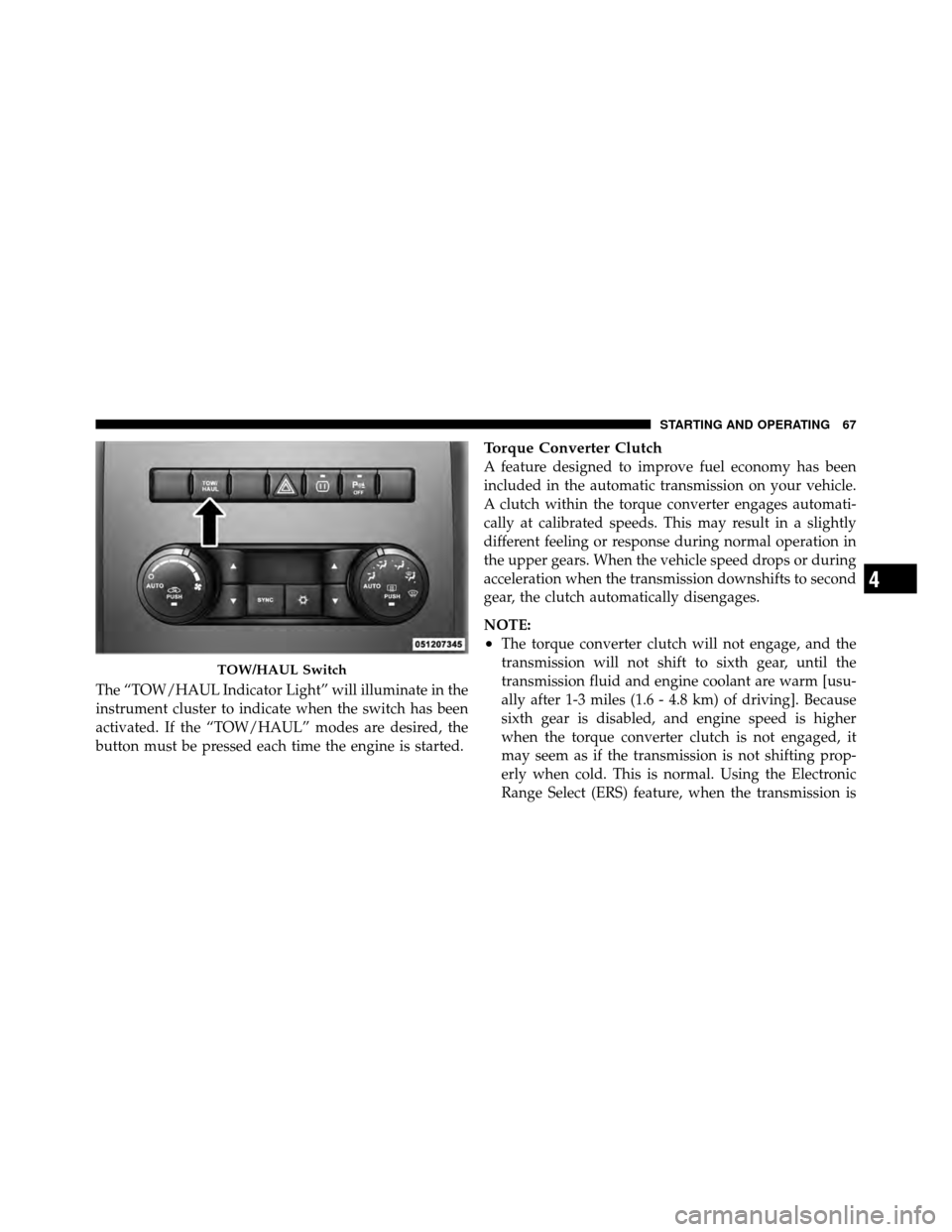Page 54 of 170

NOTE:For EVIC messages related to the vehicle’s
exhaust system, refer to “Maintenance Procedures/
Intervention Regeneration Strategy – EVIC Message Pro-
cess Flow” in “Maintaining Your Vehicle” for further
information.
Idle-Up Feature – Automatic Transmission Only
The driver-controlled high idle speed feature will help
increase cylinder temperatures and provide additional
cab heat, however, excessive idling may still cause the
exhaust aftertreatment system to not properly regenerate.
Extended periods of idle time should be avoided.
The Idle-Up feature uses the speed control switches to
increase engine idle speed and quickly warm the vehi-
cle’s interior.
1. With the transmission in PARK, the parking brake
applied, and the engine running, press the speed control
switch to the ON position, then press the SET switch. 2. The engine RPM will go up to 1100 RPM. To increase
the RPM, press and hold the ACCEL/RESUME switch
and the idle speed will increase to approximately 1500
RPM. To decrease the RPM, press and hold the DECEL
switch and the idle speed will decrease to approximately
1100 RPM.
3. To cancel the Idle–Up feature, either press the CAN-
CEL switch, press the ON/OFF switch, or press the brake
pedal.
Stopping The Engine
Idle the engine a few minutes before routine shutdown.
After full load operation, idle the engine three to five
minutes before shutting it down. This idle period will
allow the lubricating oil and coolant to carry excess heat
away from the combustion chamber, bearings, internal
components, and turbocharger. This is especially impor-
tant for turbocharged, charge air-cooled engines.
4
STARTING AND OPERATING 53
Page 56 of 170

Engine Speed Control
CAUTION!
Prevent overspeeding the engine going downhill.
When descending steep grades, use a combination of
gears and service brakes to control vehicle/engine
speed. Overspeed can cause severe engine damage.
Operating Precautions
Avoid Overheating The Engine
The temperature of the engine coolant (antifreeze) (a
mixture of 50% ethylene-glycol and 50% water) must not
exceed the normal range of the temperature gauge 240°F
(116°C) with a 16 psi (110 kPa) radiator cap.
Usually the engine coolant (antifreeze) temperature indi-
cated during operation will be to the left of center in the
normal range of the gauge.
Avoid Low Coolant Temperature Operation
Continual operation at low engine coolant (antifreeze)
temperature below the normal range on the gauge 140°F
(60°C) can be harmful to the engine. Low engine coolant
(antifreeze) temperature can cause incomplete combus-
tion which allows carbon and varnish to form on piston
rings and injector nozzles. Also, the unburned fuel can
enter the crankcase, diluting the lubricating oil and
causing rapid wear to the engine.
Cooling System Tips – Automatic Transmission
To reduce potential for engine and transmission over-
heating in high ambient temperature conditions, take the
following actions:
•City Driving —
When stopped, shift the transmission into NEUTRAL
and increase engine idle speed.
•Highway Driving —
Reduce your speed.
4
STARTING AND OPERATING 55
Page 57 of 170

•Up Steep Hills —
Select a lower transmission gear, but try and keep the
torque converter clutch engaged.
•Air Conditioning —
Turn it off temporarily.
Do Not Operate The Engine With Low Oil
Pressure
When the engine is at normal operating temperature, the
minimum oil pressures required are:
Idle 700 to 800 RPM ............... 10psi(69kPa)
Full speed and load .............. 30psi (207 kPa)
CAUTION!
If oil pressure falls to less than normal readings, shut
the engine off immediately. Failure to do so could
result in immediate and severe engine damage.
Do Not Operate The Engine With Failed Parts
Practically all failures give some warning before the parts
fail. Be on the alert for changes in performance, sounds,
and visual evidence that the engine requires service.
Some important clues are:
•engine misfiring or vibrating severely
•sudden loss of power
•unusual engine noises
•fuel, oil or coolant leaks
•sudden change, outside the normal operating range, in
the engine operating temperature
•excessive smoke
•oil pressure drop
56 STARTING AND OPERATING
Page 58 of 170

ENGINE BLOCK HEATER — IF EQUIPPED
The engine block heater warms engine coolant and
permits quicker starts in cold weather. Connect the heater
cord to a ground-fault interrupter protected 110–115 Volt
AC electrical outlet with a grounded, three-wire exten-
sion cord.
The engine block heater cord is routed under the hood to
the right side and can be located just behind the grille
near the headlamp.
NOTE:The engine block heater cord is a factory in-
stalled option. If your vehicle is not equipped, heater
cords are available from your authorized MOPAR�
dealer.
The block heater must be plugged in at least one hour to
have an adequate warming effect on the coolant.WARNING!
Remember to disconnect the cord before driving.
Damage to the 110–115 Volt electrical cord could
cause electrocution.
NOTE: The block heater will require 110 Volts AC and
6.5 Amps to activate the heater element.
Block Heater Usage
For ambient temperatures below 0°F (-18°C), engine
block heater usage is recommended.
For ambient temperatures below –20°F (-29°C), engine
block heater usage is required.
4
STARTING AND OPERATING 57
Page 60 of 170

WARNING!
Do not use the exhaust brake feature when driving in
icy or slippery conditions as the increased engine
braking can cause the rear wheels to slide and the
vehicle to swing around with the possible loss of
vehicle control, which may cause an accident possi-
bly resulting in personal injury or death.
NOTE: For optimum braking power it is recommended
to use the exhaust brake while in TOW/HAUL mode.
The purpose of the exhaust brake (engine braking) fea-
ture is to supply negative (braking) torque to the engine.
Typically, the engine braking is used for, but not limited
to, vehicle towing applications where vehicle braking can
be achieved by the internal engine power, thereby spar-
ing the mechanical brakes of the vehicle. Benefits of the exhaust brake are:•vehicle driving control
•reduced brake fade
•longer brake life
•faster cab warm-up.
The exhaust brake feature can also be used to reduce the
engine warm up time. To use the exhaust brake as a
warm-up device, the vehicle must be stopped or moving
less than 5 mph (8 km/h), the exhaust brake switch must
be in the ON position, and the coolant temperature must
be below 180°F (82°C) and ambient temperature below
60°F (16°C).
4
STARTING AND OPERATING 59
Page 66 of 170

NEUTRAL
Use this range when the vehicle is standing for prolonged
periods with the engine running. The engine may be
started in this range. Set the parking brake if you must
leave the vehicle.
DRIVE
This range provides underdrive first, second and third
gears, direct fourth gear and overdrive fifth and sixth
gears. The shift into overdrive fifth and sixth gear occurs
only after the transmission has completed the shift into
fourth gear. No other movement of the shift mechanism
is required to complete the 4–5 or 5–6 gear shifts.
Upshifts into both overdrive gears, fifth and sixth, will be
delayed when the transmission fluid temperature is
below 40°F (4.5°C) or above 240°F (115.5°C).NOTE:
Use caution when operating a heavily loaded
vehicle in second or first gear in high ambient tempera-
tures as torque converter slip can impose significant
additional heat load on the cooling system.
Overdrive Operation
The overdrive automatic transmission contains an elec-
tronically controlled fifth and sixth (Overdrive). The
transmission will automatically shift from DRIVE to
Overdrive if the following conditions are present:
•the shift lever is in DRIVE;
•the engine coolant has reached normal operating tem-
perature;
•vehicle speed is above approximately 30 mph
(48 km/h);
•the “TOW/HAUL” switch has not been activated;
4
STARTING AND OPERATING 65
Page 68 of 170

The “TOW/HAUL Indicator Light” will illuminate in the
instrument cluster to indicate when the switch has been
activated. If the “TOW/HAUL” modes are desired, the
button must be pressed each time the engine is started.
Torque Converter Clutch
A feature designed to improve fuel economy has been
included in the automatic transmission on your vehicle.
A clutch within the torque converter engages automati-
cally at calibrated speeds. This may result in a slightly
different feeling or response during normal operation in
the upper gears. When the vehicle speed drops or during
acceleration when the transmission downshifts to second
gear, the clutch automatically disengages.
NOTE:
•The torque converter clutch will not engage, and the
transmission will not shift to sixth gear, until the
transmission fluid and engine coolant are warm [usu-
ally after 1-3 miles (1.6 - 4.8 km) of driving]. Because
sixth gear is disabled, and engine speed is higher
when the torque converter clutch is not engaged, it
may seem as if the transmission is not shifting prop-
erly when cold. This is normal. Using the Electronic
Range Select (ERS) feature, when the transmission is
TOW/HAUL Switch
4
STARTING AND OPERATING 67
Page 72 of 170

REVERSE
This range should be used only after the vehicle has come
to a complete stop.
NEUTRAL
Use this range when the vehicle is standing for prolonged
periods with the engine running. The engine may be
started in this range. Set the parking brake if you must
leave the vehicle.
DRIVE
This range provides all forward gears, including fourth
gear direct, fifth and sixth. Use this range for most city
and highway driving. Upshifts into both overdrive gears,
fifth and sixth, will be delayed when the transmission
fluid temperature is between -4°F (-20°C) and 41°F (5°C).
During very cold conditions when the transmission fluid
is below -4°F (-20°C), the transmission will be limited to
third gear. Normal operation will return after the trans-
mission fluid warms up.NOTE:
Use caution when operating a heavily loaded
vehicle in second or first gear selections in high ambients
as torque converter slip can impose significant additional
heat load on the cooling system.
Overdrive Operation
The Overdrive automatic transmission contains an elec-
tronically controlled fifth and sixth gear. The transmis-
sion will automatically shift from DRIVE to fifth or sixth
gear if the following conditions are present:
•the shift lever is in DRIVE;
•the engine coolant has reached normal operating tem-
perature;
•vehicle speed is above approximately 38 mph
(61 km/h) for fifth gear and 50 mph (80 km/h) for
sixth gear;
•the “TOW/HAUL” switch has not been activated
(sixth gear is inhibited in “TOW/HAUL” mode);
4
STARTING AND OPERATING 71